Scientific creativity and repetitive tasks do not go well together. There is nothing worse than having to repeat the same task over and over again – I know somebody who quit science because of this and became a castle curator. So how do you minimise the amount of one of the most repetitive tasks – pipetting – while maximising the amount of PCR product?
The Mix
I’ll start from the premise that you have already optimised your PCR reaction, you know the best conditions and have established the PCR cannot be replaced by cloning your fragment and doing a maxiprep. First of all – and this is true for any experiment where you have a large number of identical samples – do not mix your components separately into each tube. Make a master mix, where you add all ingredients in volume multiplied by the number of samples in one tube and then aliquot into separate tubes. The additional advantage of this method is avoiding pipetting errors, which accumulate when you pipette small amounts of liquid.
The Template
If you don’t need a high level of fidelity from you PCR product, e.g. you are not going to use it for cloning and protein overexpression, you can change your template from the genomic DNA or plasmid to the PCR product itself and increase its initial concentration, which will lead to the increase in the final amount of product.
The concentration of buffer, dNTP and enzyme is usually optimised, so don’t mess with them. Instead you can try increasing the number of the amplification circles from the usual 30 to 35 – 40, which can increase the amount of PCR you are getting.
The Machine
Most modern PCR machines allow you to adjust for the volume in the tubes, so 50 µl will be in the same conditions as 200 µl. However, as you increase the volume, the speed of heat transfer from the tube sheath to the tube and liquid inside change, so be careful not to overdo it. It is easy to make a set of tubes from the master mix and try out different volumes and comparing the concentration of product per micro litre of reaction. Simply changing the tubes from the tried and tested is risky, because the plastic thickness is different, so this could significantly change the reaction conditions.
The Vessels
If you have one of the fixed volume PCR machines, you can use strips or even plates for qPCR (in the qPCR machine) and aliquot: not having to close and then open 20 little lids on the individual tubes will save you a lot of time.
Have you any tips on PCR set-up?







